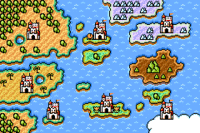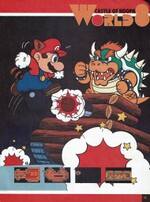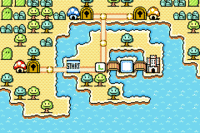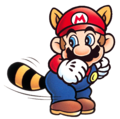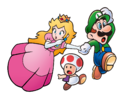Super Mario Bros. 3
Template:Articleabout Template:Infobox Super Mario Bros. 3 is a platform action-adventure game for the Famicom and NES and is officially the third installment in the Super Mario Bros. series. It was released in Japan on October 23, 1988; in North America on February 9, 1990; and in Europe and Australia on August 29, 1991. It was later released in the US on the Wii's Virtual Console on November 5, 2007 and the 3DS and Wii U Virtual Console on April 17, 2014. It was also remade for the 1993 SNES compilation game Super Mario All-Stars, and for the Game Boy Advance in 2003 as Super Mario Advance 4: Super Mario Bros. 3, the final installment of the Super Mario Advance series. It was also released as a reward that Club Nintendo users could purchase with their coins for the Wii Virtual Console on June 3, 2013.
Super Mario Bros. 3 has been considered as one of the greatest games of all time. Its complexity and challenging levels made it a huge success. In addition to new power ups, it features new moves, items and enemies. It also features special non-level parts of each world, including Toad Houses, where items can be obtained, and Spade Panels, where lives can be obtained, as well as some secret parts, such as the White Mushroom House and the Treasure Ship. The game introduces six new power-ups, the Super Leaf, the Tanooki Suit, the P-Wing, the Frog Suit, the Hammer Suit, and Goomba's Shoe.
Shortly after the release of the game, a cartoon named The Adventures of Super Mario Bros. 3 was made. The cartoon was based on the game, but with a different plot. In the cartoons, King Koopa and the Koopalings tried to take over the real world as well as the Mushroom Kingdom. The cartoon series was produced by DIC Entertainment Productions in association with Nintendo.
Story
Peace has returned to the Mushroom Kingdom thanks to the efforts of Mario and Luigi; however, Bowser sent his own seven children (Larry, Morton, Wendy, Iggy, Roy, Lemmy, and Ludwig) to the other countries of the Mushroom World. The Mushroom Kingdom forms a gateway to these lands, and the Koopalings have stolen the respective royal magic wands of the seven kings, using them to transform the kings into various helpless creatures. Mario and Luigi vow to go and stop the Koopalings' mischief, and change the kings back into their normal form. At the end of each world, Mario and Luigi fight one of the Koopalings, and after the match is over, retrieve the wand from the Koopaling to turn the king back to normal. While the brothers are out in their adventure, Bowser kidnaps Princess Toadstool and takes her to his lair in Dark Land. The brothers go to Dark Land and fight Bowser. After defeating Bowser, they save the princess and restore peace once again.
Worlds
Unlike Super Mario Bros. and Super Mario Bros. 2, this game is the first Mario game that has a world map, a feature that has been carried over into every subsequent title in the series. Like Super Mario Bros., the game features eight total worlds spread out across eight different maps, each one featuring a different name, theme, and boss; the inclusion of thematic worlds would also be carried over into future titles in the series.
World 1: Grass Land
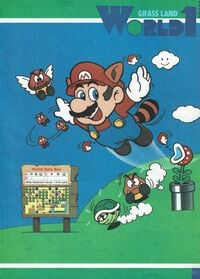
Grass Land is the first world of the game. It was attacked by Larry Koopa, who stole the wand of the Grass Land king and turned him into a dog (or a Cobrat from Super Mario Bros. 2 in the remake). The landscape itself is mainly composed of plains, surrounded by hills and even some cliffs in the south. A fortress can be found in the middle of Grass Land, and the king's castle lies to the southeast, surrounded by a circular moat. The enemies Mario encounters here are regular ones, like Goombas, Koopa Troopas and Piranha Plants. The world features a Spade Panel, two Toad Houses and six levels, of which four have to be cleared to reach the king's castle.
World 2: Desert Land
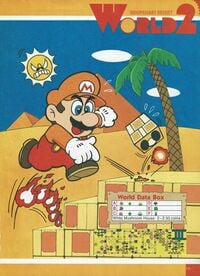
Desert Land is the second world of the game. It is a region within a vast desert, filled with sand, palm trees and some pyramids. A fortress is located in the west part of the desert, and a quicksand field can also be found, as well as a great pyramid that the player needs to traverse in order to reach the king's castle. The king was attacked by Morton Koopa Jr., who turned him into a spider (or a Hoopster from Super Mario Bros. 2 in the remake). The world features two Spade Panels and three Toad Houses, of which one lies in a secret area behind a rock that needs to be crushed by a Hammer.The boulder also hides two Fire Brothers which stole the last Warp Whistle. Four of the five levels need to be cleared to get to the great pyramid and the castle. Desert Land houses many desert-related creatures like Fire Snakes and the extremely rare Angry Sun.
World 3: Water Land
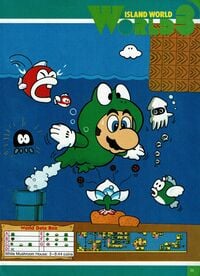
Water Land is a water-themed region that was raided by Wendy O. Koopa, who turned the king into a kappa (or a Dino-Rhino from Super Mario World in the remake). While some levels take place on solid ground, most of the levels and even one of the worlds two fortresses involve water in a certain way. At the northern part of the world map, Mario will encounter drawbridges that open and close in a set pattern. The world's castle is located far to the east on a small remote island that is only accessible through a Warp Pipe. A boat can be unlocked by using a Hammer on a rock in the south. Through it, the player can reach some bonus Spade Panels and Toad Houses. Water Land contains nine levels in total, of which one can be skipped if a certain drawbridge is closed, and houses several water creatures like Bloopers, Cheep Cheeps, and Big Berthas. The world also introduces a very rare Boo known as a Stretch.
World 4: Giant Land
Giant Land is mainly composed of an island in the vague shape of a Koopa. It is a relatively green island with plants growing on it that resemble Fire Flowers. The castle at the west coast of the island was attacked by Iggy Koopa, who transformed the king into an orange dinosaur (or Donkey Kong Jr. in the remake). The world has two fortresses, one on the east side and one on a small island in a lake in the world's center. The most prominent feature of Giant Land, which gives this world its name, is the fact that many enlarged versions of regular enemies, blocks, and environmental features can be found here. The world features four Toad Houses, two Spade Panels and six levels, of which five need to be cleared to reach the king's castle.
World 5: Sky Land
Sky Land is the world that has been conquered by Roy Koopa, who has turned its king into a condor (Albatoss in the remake). It is divided into two parts: a ground part and a sky part. The player begins on the ground. The most notable feature of this area is the possibility to gain the Goomba's Shoe, an item that can be obtained in level 5-3. After clearing the levels on the ground, the player can reach a spiraling tower that reaches up to the sky. The main part of the level is located here, and there are also some creatures exclusively to this realm, namely the Para-Beetle. After clearing the tower that serves as a link between the two areas, the player can go back to the ground, but they will have to clear the tower again on their way up. If the Koopaling isn't defeated at the first try, his Airship will be able to move freely between sky and ground. There are nine levels in total, three Spade Panels, three Toad Houses and two fortresses. The castle is on the southwest part of the sky part.
World 6: Ice Land
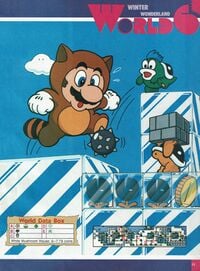
Ice Land is an area covered in snow and ice. The castle was attacked by Lemmy Koopa - who has turned its king into a fur seal (Monty Mole in the remake) and Mario has to venture there and reclaim the magic wand just like in the previous worlds. Before he can reach the castle however, the player has to navigate Mario through the levels of Ice Land. These levels feature frozen ground which makes movement more difficult, as Mario has poor footing on them and is likely to slip off into a bottomless pit. In some levels, the player can find ice blocks that contain coins or enemies. These blocks can only be melted with one of Fire Mario's fireballs. There are ten levels in total, three Spade Panels, two Toad Houses, and three fortresses. The castle is far to the east near the sea.
World 7: Pipe Land
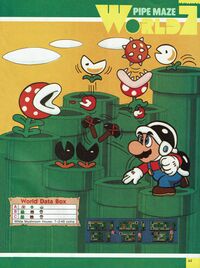
Pipe Land is a series of small islands in a network of confusing pipes. The fourth stage is an underwater level with spiked Cheep Cheeps, some Big Berthas and three Blooper Nannies. Ludwig von Koopa attacked Pipe Land's king and turned him into a goldenrod Venus Fire Trap (Yoshi in the remakes). The country itself consists of nine levels, three Spade Panels, two fortresses, two Nipper Plant Levels and three Toad Houses. The castle is located in southeastern Pipe Land by the sea. If not defeated, the airship will fly from one island to another since the anchor is required to stop it.
World 8: Dark Land
The eighth and final world is ruled by King Bowser. The levels in this world are primarily tank brigades and airships. There are also Hand Traps found in the second area of the world, which unexpectedly grab Mario or Luigi and take them to a short obstacle course which has a chest containing a Super Leaf at the end. The third area has two normal levels and a fortress, and the final level has the last tank level and Bowser's Castle, where Mario or Luigi must finally battle Bowser.
World 9: Warp Zone
World 9 is only accessible by a Warp Whistle. In it, the player can choose to go to any other world in the game. The selection of worlds the player can choose from changes depending on the world they used the Warp Whistle in. If the player uses another Warp Whistle in the Warp Zone, it will take them to the pipe leading to World 8. It is not possible to return to the world from which Mario accessed the Warp Zone.
World-e
World-e is an e-Reader-based world that is only exclusive to Super Mario Advance 4: Super Mario Bros. 3. It can be reached right at the very beginning of the game. Players can use two Game Boy Advance, one with the game and the other with the e-Reader in order to scan level cards, demo cards, and power-up cards.
Gameplay
Controls
In a level
: Move
/
 : Jump
: Jump/
 : Dash/pick up
: Dash/pick up/
: Pause
On the world map
: Move Mario Around the map.
/
 : Select level/item
: Select level/item/
 : Open the item menu
: Open the item menu
Transformations
| Small Mario | Mario's weakest form used when a new game begins. If Mario touches an enemy while in this form, he loses a life. | |
| Super Mario | The form Mario turns into after obtaining a Super Mushroom in small form. Mario gains the ability to break Brick Blocks in this state. If Mario touches an enemy while in this form, he shrinks back to his small form. | |
| Fire Mario | After utilizing a Fire Flower, Mario will turn into Fire Mario, giving him the ability to defeat enemies by shooting fireballs at them. | |
| Raccoon Mario | After using the Super Leaf, Mario will transform into Raccoon Mario. In this state, Mario can spin his tail to attack most enemies, and he can also fly for a short period of time after gaining enough speed. | |
| Tanooki Mario | After obtaining the Tanooki Suit, Mario transforms into Tanooki Mario. Along with the abilities to fly and attack with his tail, Mario can turn into a statue to confuse his enemies for a short period of time. | |
| P-Wing | The P-Wing looks and behaves similarly to the Raccoon Suit, but includes a large "P" on Mario's chest and allows for indefinite flight. (On the action screen Mario appears as a normal Raccoon Mario, but the player's Power Meter is constantly filled.) After a level is cleared with this form, Mario will transform back into Raccoon Mario. | |
| Frog Mario | Mario will turn into Frog Mario after retrieving the Frog Suit. The Frog Suit allows Mario to swim much easier, but impedes his movement on land drastically. | |
| Hammer Mario | Upon obtaining the Hammer Suit, Mario will turn into Hammer Mario. In this state, Mario can defeat enemies by throwing hammers, and can shield himself from fireballs by using his shell, but cannot slide down hills. | |
| Invincible Mario | After getting a Starman, Mario will become invincible, and cannot be harmed by any enemies or obstacles. Along with the bonus of invincibility, Mario can also defeat most enemies without jumping on or throwing projectiles at them. This will only last for a short period of time (considerably shorter than other Mario games), and Mario will still lose a life if he falls into an abyss or in a pool of lava. |
Another object is the Goomba's Shoe, only obtainable in World 5-3 of the game. This object allows Mario to safely hop across dangerous objects and jump on spiky enemies, such as Piranha Plants and Spinies. It is obtained from attacking a Goomba hopping in the shoe from below. It is only found in this game and its remakes. However, since it is not a power-up it does not overtake any previous powers the player may have had. For example, if Fire Mario went in a Goomba's Shoe, then lost it, he would still retain his fire-throwing ability, similar to Yoshi in the SNES game Super Mario World.
In international releases of this game, after players obtain a power-up that is greater than a Super Mushroom, any injury will turn them back to their super form, like in every platformer Mario game after Super Mario World. In the original Japanese Famicom release, any hit reduces the player back to small form, like in Super Mario Bros., Super Mario Bros: The Lost Levels and Super Mario World.
Enemies
- Battle Mode
- Goombas
- Koopas
- Buzzies
- Piranha Plants
- Lakitu
- Hammer Brothers
- Fortress
- Water
- Baby Cheep
- Big Bertha
- Blooper
- Blooper Baby
- Blooper Nanny
- Boss Bass
- Cheep-Cheep
- Jelectro
- Lava Lotus
- Spiny Cheep-Cheep
- Desert
- Chomps
- Artillery
- Bill Blaster
- Bob-omb
- Bullet Bill
- Cannon
- Cannonball
- Giant Cannonball
- Missile Bill
- Rocket Engine
- Rocky Wrench
Bosses
2-Player
In two-player mode, Mario (player one), and Luigi (player two) taking turns to complete the level, just like Super Mario Bros.. After one brother completes a level/loses a life, the other brother plays. Also, if one brother picks a level that the other brother completed, they enter versus mode in their small forms.
Some versus mode stages are similar to Mario Bros. The player that defeats three of five enemies or survives wins. Enemies to defeat are Spinies, Sidesteppers, and Fighter Flies, but defeating a Fireball does not count. Players can indirectly kill each other by forcing the rival to collide with an enemy to gain victory. Players can also steal Roulette Box cards from each other by bumping from below. One stage involves grabbing three of five coins.
There is also a stage that has a vertical pipe that shoots out Fireballs and coins. The player that collects three coins or survive wins. Another stage has the players climbing ladders to retrieve coins under boxes, some of which are empty. The first to obtain three wins.
Any deaths incurred in the versus mode will not affect the player's lives in the main game. Super Mario All-Stars also includes a similar Battle Game in the main menu for Super Mario Bros 3.
Development
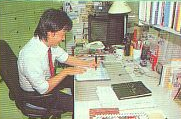
The hard part of creating a video game with old characters is making the old characters seem fresh and new.[1][2]In many ways, Super Mario Bros. 3 revived the series and brought many new young and old fans back to the adventures of the Mario Bros. The game was first shown in North America in the 1989 movie The Wizard as a way to advertise it; this also marked the first time that a Mario game was advertised in a movie.
Remakes and ports
Super Mario Bros. 3 was later remade and included in Super Mario All-Stars, with updated graphics and sound for the Super Nintendo Entertainment System, and with further minor upgrades in the re-issue, Super Mario All-Stars + Super Mario World, and the game's eventual port to the Wii as Super Mario All-Stars Limited Edition. A notable addition to the All-Stars version of Super Mario Bros. 3 was a save feature which allow players to save the progress and continue the world where they left off. Additionally, there's a Battle Game feature in the title screen that works differently from the ones featured from the maps in the 2-Player Game Mode. Other than that, retaining some localization changes and certain glitches fixed, gameplay was not altered.
Super Mario Advance 4: Super Mario Bros. 3
- Main article: Super Mario Advance 4: Super Mario Bros. 3
Super Mario Bros. 3 was ported to the Game Boy Advance handheld system as the fourth and final installation in the Super Mario Advance series, Super Mario Advance 4: Super Mario Bros. 3. It used the same graphics and sounds as the Super Mario All-Stars version, and also incorporated the use of the e-Reader: by scanning in certain cards, players could unlock new items and levels, including content originally from the other classic Mario platformers.
Reception
The game has received critical acclaim. IGN gave the game 1st place in their Top 100 NES Games list[3].
Miscellaneous
id Software's attempted PC port
PC developer id Software sent to Nintendo a demo of a PC port of the game [4], with the intent being to gain authorization to make an official port. The demo reached the Nintendo of Japan management (including Shigeru Miyamoto), who were impressed by the port's quality. However, Nintendo declined to greenlight an official PC version of the game as the company had no plan to release its products outside of their own platform[4].
The pitch followed a tech demo named Dangerous Dave in "Copyright Infringement", which was a playable recreation of World 1-1 with Mario's sprite being replaced with that of the titular character. Dangerous Dave was notable for featuring smooth scrolling, something unheard for PC games of the time[4][5].
Media
References to other games
- Mario Bros.- The Battle Mode is very similar to the multiplayer in this game.
- Super Mario Bros.- When Princess Toadstool is saved from Bowser (in English versions except Super Mario Advance 4), she says "Thank you. But our princess is in another castle!...Just kidding! Ha ha ha! Bye bye." This is a reference to the mushroom retainers' line "Thank you Mario! But our princess is in another castle!" from this game.
- Super Mario Bros. 2- Princess Toadstool's appearance is almost identical to how she appeared in this game.
References in later games
- Super Mario RPG: Legend of the Seven Stars - The music heard in Grate Guy's Casino is a rendition of music from the minigames of Super Mario Bros 3, and the theme heard during the battle with Bowser in Super Mario RPG is a cover of that from Super Mario Bros. 3.
- Super Mario 64 - Many levels in Giant Land resemble Tiny-Huge Island in Super Mario 64 and its remake. Changing sizes by using doors also resembles using pipes to go from tiny to huge in Tiny-Huge Island.
- Mario Party - The music heard in Ghost Guess and Pedal Power appears to be a cover of the Ice Land theme.
- Paper Mario - The jingle that plays when Mario rescues a Star Spirit is a cover of the theme that plays when Mario recovers a king's magic wand.
- Super Smash Bros. Melee - The main overworld theme has a cover version in both Mushroom Kingdom and Princess Peach's Castle.
- Paper Mario: The Thousand-Year Door - The theme of Ice Land plays when Jolene calls Mario.
- Tetris DS- Levels 4, 5 and 6 in Marathon mode uses Super Mario Bros. 3 gameplay on the top screen, along with the Raccoon, Frog and Tanooki Mario sprites on the touch screen. Also, a cover of the overworld theme plays.
- Dance Dance Revolution: Mario Mix - Music from Super Mario Bros. 3 is a cover version in this game.
- WarioWare: Twisted! - The Super Mario Bros. 3 microgame, along with the Super Mario Bros. 3-Lift microgame, are based on Super Mario Bros. 3.
- Super Mario 64 DS - The Rec Room theme is a cover of the Grass Land theme.
- Mario Party Advance - The music played after Mario beats a Boom Boom/Koopaling is heard after the player completes a quest. Also, in the minigame Drop 'em, the background has a similar design to the levels from Super Mario Bros. 3.
- New Super Mario Bros. - Many concepts started in here are features in this game, such as Toad Houses. A lot of the worlds have similar themes. Plus, the fortress theme is a cover.
- Super Paper Mario - The theme that plays when Big Blooper appears is a cover of the underwater theme from Super Mario Bros. 3.
- Super Smash Bros. Brawl - The main overworld theme from Super Smash Bros. Melee is re-used in this game.
- Mario Kart Wii - A license plate which reads "SMB3" can be found on one of the trucks on Moonview Highway.
- Super Mario Galaxy - The airship and athletic music is a cover version in this game.
- New Super Mario Bros. Wii - The Penguin Suit is based on the suits of Super Mario Bros. 3. The Koopalings' battle theme is a cover twice and once again played when fighting against them. The airship theme is a cover, and can be heard on airship levels. The design on the fortresses are based on the fortress sprites of Super Mario Bros. 3. The Enemy Courses are similar to the levels when fighting against a Hammer Bro, Fire Bro, Boomerang Bro, or Sledge Brother, and even use a cover of the song. Also, players can use reserve power-ups like in Super Mario Bros. 3. Also, the Parabeetle makes its second and only other appearance in the main games so far here.The Ice Flower resembles the flower from one of the Toad Houses.
- Super Mario Galaxy 2 - Supermassive Galaxy is similar to Big Island. Portions of the Water Land map theme can be heard in the World 6 map theme within 55 seconds.
- Mario & Sonic at the London 2012 Olympic Games - The Athletic Theme heard in Super Mario Bros. 3 is available in this game as one of the optional music tracks.
- Super Mario 3D Land - The Tanooki Suit, Jump Blocks, and the Super Leaf appear in this game. Also the Airships and Boom Boom battles return.
- New Super Mario Bros. 2 - Some levels contain the same colourful blocks from this game. Also, Raccoon Mario, the Super Leaf and Jump blocks return, along with the Koopalings, and in the Coin Rush Gold Classics pack, the second course is based off of World 1-1 and the coin heaven..
- New Super Mario Bros. U - Boom Boom returns as the boss of six of the Towers, Koopalings and also appear to have become personalized ships, the P-Acorn sounds and acts like the P-Wing, the first part of the Soda Jungle is based on Giant Land and many enemies from this game return.
- Mario & Luigi: Dream Team - Nipper Plants appear in this game.
- Super Mario 3D World - The enemies Spikes make their first appearance in a 3D Mario game, Also, the music that plays when Mario dies is a cover of this one.
- NES Remix 2: Super Mario Bros. 3 is one of the games that appears in this game.
Differences between Japanese and International versions
During the two year release gap between the Japanese version and the worldwide release of Super Mario Bros. 3, many changes were made while localizing the game for the International market (changes that affected gameplay were generally kept in remakes):
- In the Japanese version, when entering a stage, it wipes in to black, then wipes out the stage. In the International release, it wipes in, then the stage fades in slightly more quickly.
- In the Japanese version, getting hit while powered-up (excluding Starmans) causes the player to automatically shrink to Small Mario like in Super Mario Bros. In the International version, powered-up Mario (again excluding invincibility) is reverted to Super Mario when hit, then shrinks to Small Mario when hit again.
- When the player is hit as Tanooki, Hammer, or Frog Mario, the costume comes off and a sound effect plays in the Japanese release. In the International release, the costume disappears in a puff of smoke.
- In Toad Houses, the player can move while Toad is speaking in the Japanese version. In the International release, the player must wait until the message is completely displayed.
- In the original North American version, Castle of Kuppa was changed to Castle of Koopa in the game's ending.
- In North American revisions and the European/Australian release, the names of each world as shown in-game minus Grass Land were further altered; Desert Hill became Desert Land, Ocean Side became Water Land, Big Island became Giant Land, The Sky became Sky Land, Iced Land became simply Ice Land, Pipe Maze became Pipe Land, and Castle of Koopa became Dark Land. This actually makes it closer to how they were originally written in the instruction manuals, including the Japanese one.
- In the second room of World 1-
 Fortress in the International version, the door to Boom Boom is at the very end of the room, with the spikes above the door slightly above the rest. Comparatively, the door in the Japanese version is two blocks to the left.
Fortress in the International version, the door to Boom Boom is at the very end of the room, with the spikes above the door slightly above the rest. Comparatively, the door in the Japanese version is two blocks to the left. - The castle interiors when entering and finishing an airship stage were redesigned for the International release. Mario is standing in the center of the room rather than on the very left, a third pillar next to the very left one was removed, the column on the right is in front of the stairs rather than behind, the throne and stairs are colored golden rather than being blue like the background wall, the stairs are made slightly longer, and the shadow shading was put on the right of each pillar rather than on the left.
- The end of World 5-1 was moved to the main portion of the level rather than having a Warp Pipe that takes the player to the end of the stage. A Buster Beetle at that part was also removed for the International release. This was likely done to remove a glitch allowing the chest that appears in the secret area in this level to appear at the end of the level.
- When the player gets hit while riding a Goomba's Shoe in the Japanese version, the shoe is red as it flies offscreen, and the player is also reverted to Small Mario. It was changed to green for the International version, and the player keeps any power-ups they had before entering the shoe.
- In World 8-
 , a block was removed off the end of the final ship, allowing players to more easily jump onto the ship should they be off of it.
, a block was removed off the end of the final ship, allowing players to more easily jump onto the ship should they be off of it. - The timing for the credits sequence was altered for the International release.
- After the credits end in the International version, the player can press any button to return to the title screen and start another game in which the inventory is filled with 28 P-Wings. In the Japanese version, the player cannot do this as the game remains on the ending screen indefinitely. Even though this is not an aesthetic difference, this is one of the few gameplay changes not retained in Super Mario All-Stars.
Staff
- Main article: List of Super Mario Bros. 3 staff
Directors
- Shigeru Miyamoto
- Takashi Tezuka
Game Designers
- Shigeru Miyamoto
- Takashi Tezuka
Main Programmer
- Toshihiko Nakago
Sound Composer
Producer
Beta elements
- Main article: List of Super Mario Bros. 3 beta elements
One of the early ideas was a power-up to turn Mario into a Centaur (half-man, half-horse), although this was rejected before being implemented into the game. (Tilden 1990, 21)
Also, the game ROM contains several unused data including two new enemies called Gold Cheep Cheep (a golden version of a Cheep-Cheep), and Green Para-Beetles (green colored Para-Beetles).
Glitches
- Main article: List of glitches in Super Mario Bros. 3
Gallery
- SMB3 Boxart.PNG
Boxart
Artwork of Raccoon Mario
Artwork of Princess Peach, Toad, and Luigi
- Super Mario SMB3.PNG
A sprite of Super Mario
- Ani smb3coin.gif
A sprite of a Coin
Quotes
- "The Tanooki Suit turns into a statue! Even though I knew it wouldn't make sense to some non-Japanese players...I was so excited about it that I left it in." - Shigeru Miyamoto, Super Mario History 1985-2010 booklet
- "We were helped by many people when developing this game. But even with a larger team, I was still the worst gamer of the bunch." - Takashi Tezuka, Super Mario History 1985-2010 booklet
- "This time around, I added a lot of percussion and was able to create tracks that sounded like there were three or more sounds playing at once, resulting in much richer-sounding music." - Koji Kondo, Super Mario History 1985-2010 booklet
Trivia
- According to the Guinness Book of World Records 2008, Super Mario Bros. 3 was the world's best-selling video game, which is false.
- The image used in the book was of Super Mario Advance 4: Super Mario Bros. 3, the remake, which made the same mistake on the back of its box.
- Fire Mario's cap and shirt were orange in both the official illustration of Desert Land and in the original NES version of the game; however, later versions of Super Mario Bros. 3 changed the orange to white.
- This is the last game until Super Mario Galaxy in which all Koopa Troopas are quadrupeds and Lakitus fall off the screen with their clouds still with them if they are killed. The next game, Super Mario World, is the first game to portray all Koopas as bipeds, which is now their standard look for them, and where Lakitus either leave their cloud behind if killed, or their cloud simply puffs away.
- Despite their artwork showing otherwise, NES palette limitations caused Mario's and Luigi's player sprites to have black overalls with no gloves and red/green hat, shirt and shoes (although corrected in the larger Spade sprite), some of the Koopalings' hair and shell colors to be slightly different, and Princess Toadstool to have brown hair.
- The Koopa Troopas are traced from Super Mario Bros.
References
- ^ http://nintendope.iodized.net/smb3/smb3article2.php
- ^ [1]
- ^ [2]
- ^ a b c Dangerous Dave in "Copyright Infringement" (Retrieved July 5, 2013)
- ^ Footage of Dangerous Dave in "Copyright Infringement" on YouTube (Retrieved July 5, 2013)
External links
- Program Details for Super Mario Bros. 3 - Time Attack
- Nintendo Power Special: The making of Super Mario Bros. 3
- Nintendo Power Special: Super Mario Bros. 3 Strategy Guide
- The Mushroom Kingdom - Beta elements in Super Mario Bros. 3
